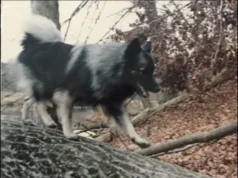They’re referred to as man’s best friend, known for being loyal, and have even risked their lives to save others. In this installment, we’re going to look at some truly memorable pooches throughout history. These aren’t your morning cartoon canines, either; these are true tales of unforgettable hounds, and whether their story is heroic, tragic, or intriguing, they all earned their place in this video! Bust out the box of tissues, you might be blubbering at the end of this one!
10Capitan
Let’s get a truly sad and heartbreaking tale out of the way first.
This is the story of a German shepherd named Capitan who shows an immense loyalty between man and beast.
In 2006 Capitan owner and best friend Manuel Guzman passed away, an event the dog took so hard that it eventually ran away. When the surviving family members visited the grave of dear Manuel a week after his death, they found Capitan laying at the graveside of his former owner.
According to Guzman’s widow, the dog had never been taken to the cemetery prior but for a period of over six years the loyal companion makes it a point to be back at the grave site at six o’clock in the evening to spend the night with his deceased owner.
9Hachiko
Love and loyalty typically go hand in hand, but it’s often wondered just how loyal an animal can be, Hachiko, an Akita, memorialized in the National Museum of Nature and Science in Tokyo is arguably a true testament of the extent of canine loyalty to their companions.
During the 1920s Hachiko was purchased by professor Hidesaburo Ueno and the two
had what could be seen as an almost immediate bond. Hachiko would accompany Hidesaburo every day to the train station, where he would sit and wait until the professor’s return. This went on for five years until the day Hidesaburo died.
Then Hachiko waited for his friend each day, performing the same routine in speculative hopes of Hidesaburo’s return. Was it a conditioned routine that Hachiko was reenacting each day, or was the lone pup really waiting for his owner? Hachiko did this during 9 years until he passed away in 1935.
A bronze statue commemorating the dog was set up in front of the Shibuya Station in 1934 a year before his death (March 8, 1935). His story has been the subject of numerous books and films.
8Pavlov’s dogs
Any psychology major is well-acquainted with Pavlov’s dogs, which were the subjects of Ivan Pavlov’s look into conditioning. During the 1890s, Pavlov sought to explain the
unconditioned responses of his dogs, who he noticed would salivate every time he entered the room assuming their owner would be bringing them food. Pavlov played around with numerous stimuli such as a bell and an assistant that dogs would eventually associate
with food and therefore salivate over.
Thanks to his hungry canines, Pavlov eventually came up with a basic concept of classical conditioning, which led to the formation of the School of Behaviorism. Unfortunately, during the siege of Leningrad, the celebrity pups were well eaten. Apparently, nobody conditioned them to run at the first sign of a starving City
7RinTinTin
The German Shepherd Rin Tin Tin is known for being a famous Hollywood dog, but the canine’s story begins long before his first film. Rin Tin Tin was amongst a litter of five puppies that was rescued by corporal Lee Duncan during World War One.
Once old enough Duncan gave away three of the pups keeping two. He dubbed them Rin Tin Tin and Nanette after a pair of good luck charms called Rintintin and Nénette that French children often gave to the American soldiers.
When he returned to the States Rin Tin Tin life of Fame began competing in dog shows and eventually working his way into silent film. The German Shepherd survived the worst of World War One and starred in dozens of movies and television shows before passing away in 1930. His legacy lives on, though, on the Hollywood Walk of Fame and a continued bloodline of service dogs.
6Bobby
Bobby The wonder dog. We’ve heard many tales of man’s feats of crossing the country in
many impressive manners but there’s something a bit more special when a lone dog can do it to find its way back home.
In 1923 Bobby, a two-year-old Scotch collie English Shepherd mix was separated from his family during a road trip to Indiana and, though the family sought long and hard, they returned home empty-handed and saddened at their apparent loss.
While the family mourned, the determined Bobby wanted one thing: to be reunited with his loving family and so Bobby began his journey, 2551 miles or 4000 kilometer trek across all kind of terrains, to return to Silverton, Oregon. After six months, Bobby
found his way home. His body surprisingly was in good shape despite the ordeal he had gone through (though he lost weight and was filthy). The collie shepherd survived and even went on to play himself in the 1924 silent film The Call of the West. Bobby died in 1927 four years after his epic Trek and has been memorialized ever since.
5Sinbad
For a period of eleven years, the USCGC Campbell was home to a very special animal that left behind a legacy that warranted the very first biography to be written about a member of the United States Coast Guard.
At the time of Sinbad service, between 1937 and 1948, military animals were considered
property of the branch they served for, but Sinbad was one of only two at the time to be promoted to a Non Commissioned Officer, earning the rank of Canine C, the canine equivalent of Chief Petty Officer.
Sinbad had originally been an intended gift for a sailor’s girlfriend, but her apartment complex didn’t allow animals, and while no crewmen on board wanted the dog, most wished for him to remain, so to enlist the animal it was stated he displayed attributes of a
sailor by drinking coffee. So Sinbad became a valuable member of the United States Coast Guard, assigned to damage control to avoid the sounds of gunfire.
Sinbad survived his scraps with German submarines and passed away peacefully on
December 30th 1951.
4Lex
During the Iraq war in 2007, corporal Dustin J Lee and his military dog Lex came under fire while working within company A’s Forward Operating Base. A 73 millimeter rocket exploded within the base, sending shrapnel everywhere. While Lex survived the attack with injuries, his handler succumbed to his wounds. Lex refused to leave Lee’s side forcing
personnel to have to drag him away.
12 weeks after the attack, Lex returned to full health and was ready to jump back into the fray, when Lee’s parents appealed to adopt the k-9. Though fully fit military dogs are
typically exempt from retirement, Lex was granted release from his duties, making her the very first fully fit active military working dog to be granted an early retirement.
3Laika
Sometimes when humans want to do something that may have a drastically negative effect on an individual’s life, they look to using something else as a stand-in.
For the 1957 Soviet launch of the Sputnik 2 spacecraft, the three-year-old mongrel Laika was chosen from the streets of Moscow to replace a human to determine the effects of spaceflight on a living organism. The testing went well but Laika died during her journey. Initially it was believed she died from a lack of oxygen shortly after
the experiment started, but a report that surfaced in 2002 stated what is believed
to be the real cause of death: Laika died six days into the experiment from overheating, possibly caused by a failure of the central r7 sustainer to separate from the payload.
2Balto the Siberian Husky
Balto was a sled dog known for acts of heroics in 1925. During this period a diphtheria outbreak was threatening to infect the young populace of Nome, Alaska, and it was only one aircraft that could deliver the medication needed from Seattle to the small town. Of course, that engine was frozen over and would not start. In desperation all eyes turn to
dog sled teams who were believed to be able to get the needed serum of diphtheria antitoxin to Nome before things got out of hand.
Led by Gunnar Kaasen and Balto, the team traversed the Iditarod Trail and completed their leg of the excursion in the dead of night. Knowing the serum was urgently needed, the team continued the run in place of another team who were asleep upon Kaasen’s arrival. Balto’s efforts were praised by the nation and after his death in 1933 his remains were mounted and donated to the Cleveland Museum of Natural History to be on display for his heroism.
1Smoky
This tiny Yorkshire Terrier is considered a hero by many after serving alongside American troops in World War II. Smoky was found in February 1944 hiding in a foxhole in New Guinea. As she didn’t respond to Japanese or English commands, the Americans that picked her up knew nothing of her origins and eventually sold her to corporal William A. Wynne.
By the end of the war the Corporal credited Smoky with having flown in 12 air and sea rescue and photo reconnaissance missions, survived 150 air raids and even acted as Wynne’s own guardian angel during a bombardment of an LST they were on, guiding him away from incoming fire.
But Smoky greatest feat was aiding in the construction of an airfield by running a telegraphed wire through dense soil potentially saving the lives of 250 men. What could have been a dangerous three-day ordeal of digging, was cut down to minutes due to Smoky’s efforts.
In 1957, many happy years after her heroism during the war, “Corporal” Smokey died at the age of 14. Wynne and his family buried Smoky in a World War II .30 caliber ammo box in Lakewood, Ohio
Nearly 50 years later, on Veterans Day, November 11, 2005, a bronze life-size sculpture, by Susan Bahary, of Smoky sitting in a GI helmet, atop a two-ton blue granite base, was unveiled there. It is placed above the very spot that Smoky was laid at her final resting place. This monument is dedicated to “Smoky, the Yorkie Doodle Dandy, and the “Dog of All Wars”





